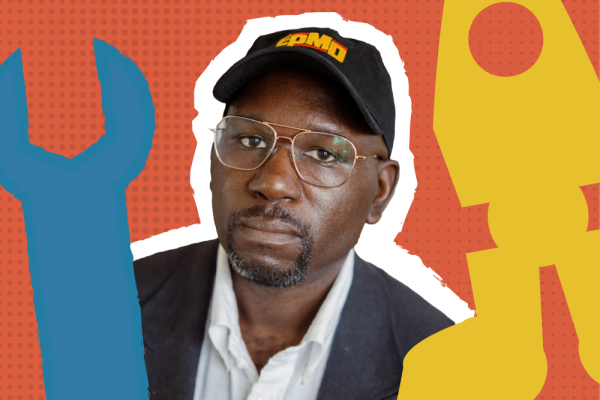Editor's note: On June 29, 2023, the U.S. Supreme Court ruled against universities that considered race as one aspect of admission decisions.
I’m proud to say that I benefitted from affirmative action. These policies, sometimes called “race conscious admission policies,” allow colleges and universities to address unequal access to educational opportunities by taking different aspects of a student’s background, including race, into account among other admission factors. But even with affirmative action in place, in 1994 I joined fewer than 25 other Black men in a freshman class of over 1,000 students at Emory University.
In the next few days, the Supreme Court is expected to end or restrict affirmative action policies in its ruling on cases against Harvard and the University of North Carolina. The plaintiff in both cases, Students for Fair Admissions, allege that “race conscious admissions policies,” discriminated against Asian American applicants; in a brief submitted to the court, 14 U.S. senators and 68 representatives agreed, writing that “laws and policies dividing people by race are immediately suspect” and alleging that these policies “harm Asian-American students and others who are unfairly judged by their race rather than by individual merit.” The universities, by contrast, have argued they only consider race as one factor among many when selecting its incoming class, a policy upheld by previous courts so schools could “achieve the educational benefits that flow from student-body diversity.” But despite previous courts’ decisions, the conservative majority of the current Supreme Court seems skeptical.
As Christians, we should yearn to make our schools (and our churches, communities, and nations!) places that celebrate diverse identities as a manifestation of the image of God in all its fullness. However, we make a mistake when we argue that affirmative action policies are primarily about maintaining diversity — an argument that obscures what affirmative action policies were originally intended to address.
Affirmative action policies were adopted in the’60s and ’70s to curtail deeply rooted discrimination against applicants of color in both education and employment. In higher education, this discrimination included segregation that persisted on some university campuses into the ’60s. Many universities originally thought of affirmative action as a forward-looking practice to ensure racism would not continue on campuses. But during his 1965 commencement speech at Howard University, President Lyndon B. Johnson expanded the meaning of affirmative action to include compensation for past injustices: “You do not take a person who, for years, has been hobbled by chains,” Johnson said, “and liberate him, bring him up to the starting line of a race and then say, ‘You are free to compete with all the others,’ and still justly believe that you have been completely fair.”
During my college years in the mid-’90s, national debates around affirmative action emerged after California passed a proposition in 1996, which said that the state cannot “discriminate against or grant preferential treatment on the basis of race, sex, color, ethnicity, or national origin in the operation of public employment, public education, and public contracting.” Many of my most formative experiences as an activist were during college when I participated in campaigns opposing efforts in Georgia and around the country to end affirmative action.
But in the decades since, proponents of affirmative action have stopped arguing that these measures are needed to address historic and ongoing racial injustice that continues to create a nation of unequal opportunity. Instead, they argue that affirmative action is needed to preserve an essential ingredient of an effective education: diversity.
Consider how the current president of my alma mater put it in an op-ed last year: “Without the ability to consider race, even in a limited way, many colleges and universities will struggle to recruit diverse classes,” wrote Emory University president Gregory L. Fenve. “If we want graduates to be prepared to solve the greatest challenges of our day, colleges and universities must give them the chance to grow and learn through their studies and from both their professors and classmates. A diverse student population makes that possible.”
While I understand the pragmatic reasons around why the diversity argument has been prioritized by legal proponents of affirmative action, we make a mistake when we use “diversity” as the main motivation. In the present moment of increasing backlash against any policy that appears race conscious or seeks to rectify previous or current forms of systemic racism, I’m convinced that the case for affirmative action can’t be rooted in purely legal or even political arguments; it also needs to be a deeply moral and religious one. While we may suffer a bitter loss in the Supreme Court in the days to come, we can’t afford to lose the greater battle for racial justice in the court of public opinion, which will require changing the hearts and minds of people in the U.S. around the ongoing imperative for many forms of repair, including affirmative action.
A 2019 study by researchers at Yale University found that Americans believe that Black households own $90 in wealth for every $100 held by white households. If only this were true! In reality, for every $10 of Black wealth, white Americans have $100, a heartbreaking gap that, by some estimates, could take more than a century to reverse.
According to an annual congressionally mandated report on the U.S. education system, Black, Hispanic, and American Indian/Alaskan Native students were more likely to live in high-poverty schools than the national average — and students in these schools were more likely to be below national averages in both reading and math. This gap persists into higher education, where Black and Hispanic students are less likely to enroll in college and, when they do enroll, complete a degree. To add insult to injury, a college education doesn’t pay off for Black and Hispanic students the same way it does for other groups; one study found that “Black college graduates are about as likely to be unemployed as white Americans with a high school diploma.” This disparity — the result of centuries of racial inequality and injustice, coupled with a nation that continues to criminalize and marginalize Black life — is the strongest argument for the ongoing need for affirmative action among other forms of repair, including reparations.
As Christians, we are people who believe repentance is key to renewal. When we look at our nation’s history of slavery and ongoing manifestations of systemic racism — including Jim Crow, redlining, mass incarceration, and police violence, to name a few — it’s clear we have failed to honor the image of God that is bestowed equally on each of us.
The Apostle Paul writes in 2 Corinthians 5:18-19 that Jesus not only has reconciled us to God, but “has given us the ministry of reconciliation.” In other words, by restoring our right relationship to God, Jesus made it possible for us to live in right relationship with others. This kind of reconciliation is far more than forgiveness; it requires effort to repair what is broken between people. Affirmative action is one critical way in which we seek right relationship by ensuring that everyone has an equal opportunity to realize their full potential.
Jesus demonstrated his own version of affirmative action by spending most of his short time in public ministry healing and ministering to lepers, prostitutes, widows, and others who were impoverished and excluded. Contemporary policies that support those who have been most excluded and discriminated against echo the very spirit of Jesus’ affirmative action for the most vulnerable and marginalized of his time. Affirmative action remains a vital tool in the toolbox to close the gap between the promise of America’s cherished ideals of liberty and justice for all and our present reality.
Got something to say about what you're reading? We value your feedback!







